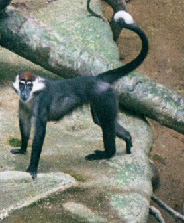White-collared Mangabey (Cercocebus torquatus)
MORPHOLOGY:
The molars of this species are long and the incisors are very large (Fleagle, 1988). The white-collared mangabey has long limbs and a long tail (Fleagle, 1988). The average body mass for captive individuals ranges from 9 to 10 kilograms for males and 7.5 to 8.6 kilograms for females.
RANGE:
The white-collared mangabey is found in the countries of Cameroon, Congo, Equatorial Guinea, Gabon, Ghana, Guinea, Ivory Coast, Liberia, Nigeria, and Sierra Leone. This species lives in both swamp and dryland forests. |
 |
 |
ECOLOGY:
The white-collared mangabey is primarily feeds on fruits and seeds, but also eats leaves, foliage, flowers, animal prey, and gum. This species is arboreal and diurnal. Group sizes for this species range from 7 to 60 individuals.
LOCOMOTION:
The white-collared mangabey moves through the forest in a quadrupedal manner (Fleagle, 1988). |
SOCIAL BEHAVIOR:
In the white-collared mangabey the males disperse from their natal groups and the females are philopatric. Females of this species form a linear heirarchy. The main core of the group is the adult females and the offspring. The social system of this species is either single male or multimale (Fleagle, 1988). The white-collared mangabey forages in small groups that split off from the larger main group. Social grooming does occur, but the receiver usually never reciprocates and mothers only groom juvenile and not infant offspring (Estes, 1991). |
 |
VOCAL COMMUNICATION:
loud call: This call is used by the white-collared mangabey to maintain distances between groups in the dense foliage of the forests.
Whoop-gobble: This call serves to communicate spacing and is only used by sexually mature males. This call may be heard for a distance of up to 1 kilometer. The call may be broken down into the whoop which communicates other group members to take notice, and the gobble which functions to give the location of the caller and his identity.
chuckle: This sound functions as an alarm call in the white-collared mangabey, and is uttered rapidly in a long series and is a high-frequency call (Estes, 1991).
progression calls: This call consists of nasal grunts that have a short range, and they are emitted by group members to no specific receiver when the group starts to move (Estes, 1991). Usually adult males do not emit these calls, and the calls tend also to communicate who is giving the call because there some individual variation amongst callers (Estes, 1991).
greeting grunts: These grunts are emitted by males when juveniles approach them; it is used to reassure them (Estes, 1991).
OLFACTORY COMMUNICATION:
genital-sniffing: This is when a male white-collared mangabey sniffs the female in response to her presenting to him; he is checking whether the female is in estrus or not (Estes, 1991).
VISUAL COMMUNICATION:
staring: This display by the white-collared mangabey is used as a threat display (Estes, 1991). The eyes are fixed on the stimulus and the eyebrows are raised and the scalp is retracted, the facial skin is also stretched by moving the ears back (Estes, 1991). Underneath the eye lids the color is different which contrasts sharply with the surrounding facial color (Estes, 1991)>
staring with open mouth: This is the stare accompanied by the mouth being open but the teeth are covered (Estes, 1991). This is a threat expression and often occurs with head-bobbing (Estes, 1991).
head-bobbing: This is used as a threat display by the white-collared mangabey and head bobs up and down (Estes, 1991). This often occurs with staring with open mouth (Estes, 1991).
pouting: This visual display is given by the females and communicates sexual receptivity (Estes, 1991). This is when the lips are protruded forward (Estes, 1991).
social presenting: This is when a nonestrus individual presents the anogenital region to another (Estes, 1991). This display is most often used to appease aggression (Davis, 1964); it is used by a subordinate towards a more dominant individual in the group (Estes, 1991).
TACTILE COMMUNICATION:
mounting: Apart from a sexual context, this is used most often by a dominant individual towards a subordinate, and occurs between members of the same sex (Estes, 1991).
REPRODUCTION:
The white-collared mangabey gives birth to a single offspring.
REFERENCES:
Burton, F. 1995. The Multimedia Guide to the Non-human Primates. Prentice-Hall Canada Inc.
Davis, D.E. 1964. The Physiological Analysis of Aggressive Behavior. In Social Behavior and Organisation Among Vertebrates. Ed. W. Etkin. University of Chicago Press.
Estes, R.D. 1991. The Behavior Guide to African Mammals. University of California Press.
Fleagle, J. G. 1988. Primate Adaptation and Evolution. Academic Press. |
 |
Last Updated: October 6, 2003.
[The Primata] [Primate Fact Sheets] [Subfamily Cercopithecinae] [Cercocebus Links]



